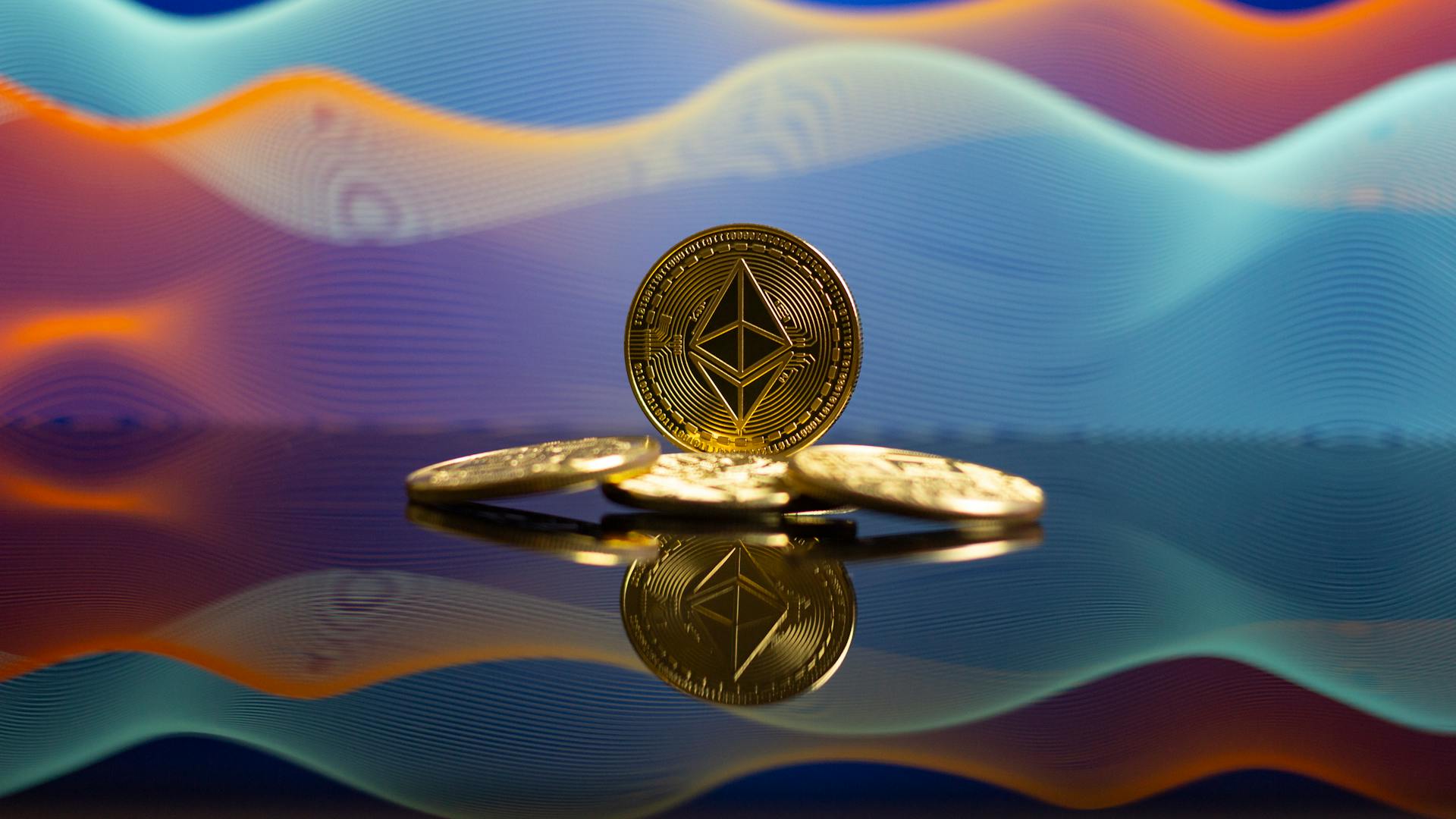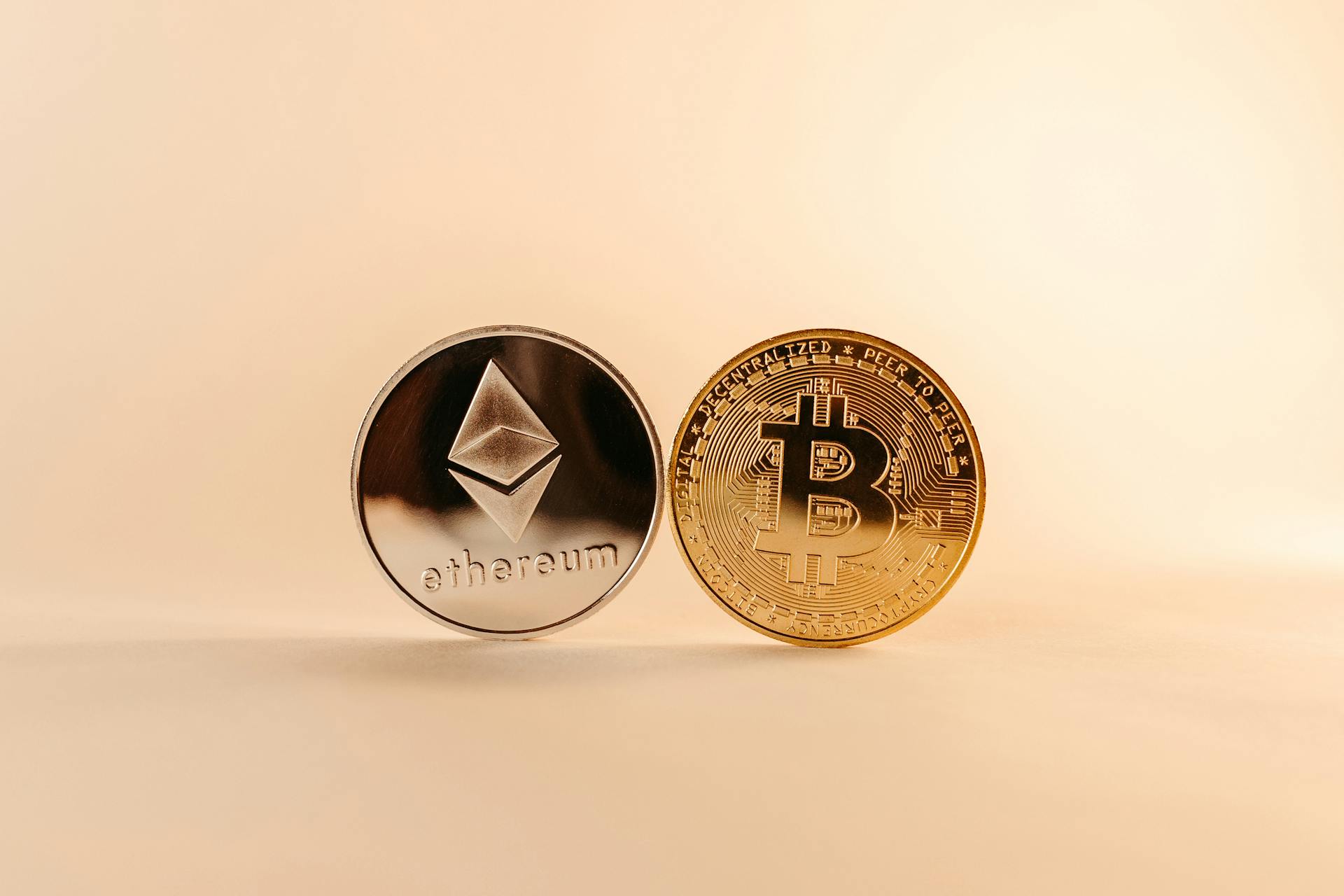
Mining Ethereum Classic can be a rewarding experience, but it requires the right equipment and setup. To start, you'll need a computer with a strong graphics card, as Ethereum Classic uses a Proof of Work (PoW) consensus algorithm.
Ethereum Classic is a hard fork of the original Ethereum blockchain, created in 2016 after a contentious hard fork. This means that the network uses the same consensus algorithm and mining process as Ethereum.
To mine Ethereum Classic, you'll need to download and install a mining software, such as MinerGate or CGMiner. These programs will help you connect to the Ethereum Classic network and start mining.
The Ethereum Classic network uses a difficulty adjustment mechanism to ensure that mining remains competitive, with the difficulty of the network increasing or decreasing every 100,000 blocks.
Mining Essentials
To mine Ethereum Classic, you'll need a wallet that's specifically designed for ETC, such as Exodus, Coinomi, or a hardware wallet.
If this caught your attention, see: Erc20 Wallet Address
You'll also need a high-end Nvidia graphics card, like the 1080 or 1080i, for optimal performance.
AMD GPUs can be used, but they're less powerful for Ethereum Classic mining.
You'll need a minimum of 4GB RAM, either dedicated video RAM or system RAM.
The best setup is a multi-GPU rig, with up to 6 GPUs combined into one mining rig.
For mining software, you can choose from Claymore Dual Ethereum miner, Ethminer, or MinerGate, which offers a user-friendly interface with no setup requirements.
However, MinerGate gives the lowest returns, so it's best for those who don't want to deal with technical aspects.
You'll also need to decide whether to solo mine or join a mining pool, with options like Nanopool and Ethermine available.
Joining a mining pool requires giving up a small percentage of your mining profits, typically around 1%.
Consider reading: What Is Pool Mining
Choosing a Miner
To mine Ethereum Classic, you'll need to choose a miner that suits your needs. The most popular options are Claymore Dual Ethereum miner and Ethminer, both of which can be used with Nvidia and AMD GPUs.
Claymore Dual Ethereum miner is a popular choice, especially for Ethereum Classic mining, and has versions for both Windows and Linux. It also supports dual mining, allowing you to mine Ethereum Classic and other coins like Siacoin or Decred.
Ethminer is another option, available for download from Github, and also supports both Nvidia and AMD cards, as well as Windows and Linux.
Choosing a Device
The best results can be achieved using graphics processors (GPUs), which are usually used in processing 3D graphics for video games.
Mining is possible on the CPU, but the GPU is initially optimized for such operations, making it better for hashing in the Ethereum network.
You'll need a high-end Nvidia graphics card, such as the 1080 or 1080i, for optimal performance. AMD GPUs can also be used, but they've been found to be less powerful for Ethereum Classic mining.
Consider using multiple GPUs, as many as 6 can be combined into one mining rig, for the best setup. This will require a minimum of 4GB RAM, either dedicated video RAM or system RAM.
Here are some recommended miners that support both AMD and NVIDIA graphics cards:
Other Miners
If you're looking for more options beyond TeamRedMiner, there are several other miners you can consider for mining Ethereum Classic.
TeamRedMiner is just one of several miners that can be used to mine ETC. There are also the less popular miners: Nanominer, SRBMiner-MULTI Miner, TeamBlackMiner, and BzMiner.
To use these miners, you'll need to know the specific commands and settings required. For example, to use nbminer, you'll need to run the command "nbminer.exe -a etchash -o stratum+tcp://etc.2miners.com:1010 -u 0xa2a43D5E417fe1c1r28c4210439E27301eDA8b2e.NameWorker" and then pause the command.
Here are some of the less popular miners you can consider:
- Nanominer
- SRBMiner-MULTI Miner
- TeamBlackMiner
- BzMiner
Keep in mind that these miners may have different settings and requirements, so be sure to check the specific instructions for each one before getting started.
Choosing a Pool
Choosing a pool can be a crucial decision for Ethereum Classic miners.
Joining a mining pool can be more effective than solo mining, particularly as network difficulty increases.
There are over 80 mining pools of Ethereum Classic to choose from, but some stand out as more popular and reliable.
The most popular pools include poolin.com, f2pool.com, ethermine.org, and 2miners.com.
Here's a brief overview of each:
Each pool has its own unique features, but they all offer a way to connect your miner and start mining Ethereum Classic.
To get started, you'll need to join a pool and configure your miner's settings. This usually involves finding the "Start Mining" or "How to Start" button on the pool's website and following the instructions.
For example, on ethermine.org, you'll need to click the "Start Mining" button, which will open a pop-up window with the necessary settings to specify in your miner.
Equipment and Setup
To mine Ethereum Classic, you'll need a video card with at least 4 GB of RAM to ensure optimal performance. Nvidia and AMD products are recommended for this purpose.
You can use an idle GPU you already have, which is a great way to start mining without any additional costs. If you're new to mining, consider using a video card with 4 GB of RAM as a good starting point.
For the mining software, you'll need to choose a program that suits your needs. Two popular options are Gminer and Lolminer.
Here's a comparison of the setup requirements for Gminer and Lolminer:
Note that both programs require you to specify your digital wallet and the pool server, among other settings. Be sure to replace the example wallet address with your own.
A unique perspective: How to Get Ethereum Wallet
Mining Configuration
Mining Configuration is a crucial step in Ethereum Classic mining. You'll need to generate a configuration file to run your miner, and there are online tools available to help you do this, such as Nanopool's Quick Start menu.
To generate your config file, click the button under step 3 in Nanopool's Quick Start menu, which will create a .zip file that you'll need to download and extract to the same folder as your miner. You'll also need to choose a secondary wallet, either SiaCoin or PascalCoin, and generate a wallet address.
You can find pool settings for your miner on the pool's website, usually under a tab called "Start Mining", "HOW TO CONNECT", or "How to Start". For example, on the ethermine pool, you'll find the settings in the "Start Mining" button.
Here's a list of the essential settings you'll need to specify in your miner:
- Server: the pool server, such as etc.2miners.com
- Port: the pool port, such as 1010
- Algorithm: the algorithm of the mined coin, such as etchash
- User: your digital wallet address, such as 0xa2a43D5E417fe1c1r28c4210439E27301eDA8b2e
Remember to specify your wallet address in the miner, and don't forget to confirm it via personal email.
Specify the Wallet
To specify the wallet in your mining configuration, you'll need to add your wallet address. This can be done by selecting ETС in the upper-left corner, then clicking on the Settings button, and finally adding your wallet address.
You can use any official wallet or the wallet of an exchange that has Ethereum Classic (ETС). Make sure to save the changes.
Here's a step-by-step guide to specifying the wallet:
- Select ETС in the upper-left corner
- Then click on the Settings button
- Add your wallet address
- Then click "Save"
- Do not forget to confirm your wallet via personal email
By following these steps, you'll be able to specify your wallet and start mining Ethereum Classic.
Pool Settings for the Miner
To get the pool settings for your miner, you'll need to visit the website of the pool you're interested in. There's usually a tab called "Start Mining", "HOW TO CONNECT", or "How to Start" that will give you the settings you need.
The settings will typically include the server address, port number, and your digital wallet address. You can find these settings on the ETC mining page of popular pools like ethermine, 2miners, and f2pool.
For example, on the ethermine pool, you can click on the "Start Mining" button to get the settings. On the 2miners pool, you'll find the "How to Start" button in the upper right corner of the mining page.
Here are some popular Ethereum Classic mining pools to consider:
Remember to configure your miner's .BAT file with the correct pool settings to start mining ETC.
Online Calculators
Online calculators are a great way to get an estimate of your Ethereum Classic mining income. You can use online calculators like Whattomine, Coinwarz, Minerstat, or 2cryptocalc to calculate your earnings.
These calculators are constantly updated and show accurate numbers. They use preloaded information such as current mining block data, network hashrate, electricity cost, and complexity.
To use these calculators, you'll need to enter your video card's hashrate, GPU power consumption in watts, and pool commission (usually 1%). The calculator will then estimate how much ETC you'll mine and how much profit you'll earn in dollars.
Here are some popular online calculators for Ethereum Classic mining:
- Whattomine
- Coinwarz
- Minerstat
- 2cryptocalc
By using these calculators, you'll get a better understanding of your mining setup and make informed decisions about your mining configuration.
Block Inflation
Block inflation is a critical aspect of mining Ethereum Classic. There's no limit on the issue of coins, but Ethereum Classic has a limit of 210.7 million coins.
The total number of coins that will be released to the market is capped at 210.7 million. This means there will always be a fixed number of ETC coins in circulation.
For another approach, see: E Interac Transfer Limit
Only 65% of the total number of coins have been mined so far, which is approximately 136.3 million coins. This leaves a significant amount of coins still to be mined.
Mining ETC will continue until around the middle of 2025. The block time for ETC is a relatively short 15 seconds, resulting in new coins entering circulation every 15 seconds.
The reward for mining a block of ETC is currently 2.48 coins. This reward is adjusted periodically, with a 20% reduction every 5 million blocks.
On a similar theme: Where Are Bitcoins Mined
Frequently Asked Questions
How long does it take to mine one Ethereum Classic?
As of December 30, 2024, it takes approximately 2.2 days to mine 1 Ethereum Classic. This timeframe is based on current mining difficulty, hashrate, and block reward.
What is the mining algorithm for Ethereum Classic?
Ethereum Classic uses the Etchash, a unique Proof of Work (PoW) algorithm that leverages a DAG file to secure its network. This algorithm is designed to provide a secure and efficient mining experience.
Can ETC still be mined?
Yes, Ethereum Classic (ETC) can still be mined, unlike its parent chain Ethereum which switched to a Proof of Stake (PoS) algorithm. Mining ETC remains an option for those interested in this alternative cryptocurrency.
Sources
Featured Images: pexels.com


